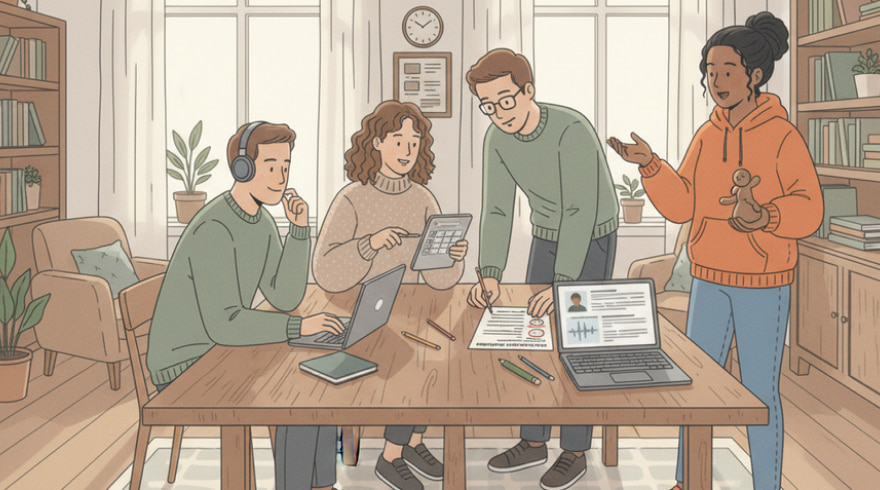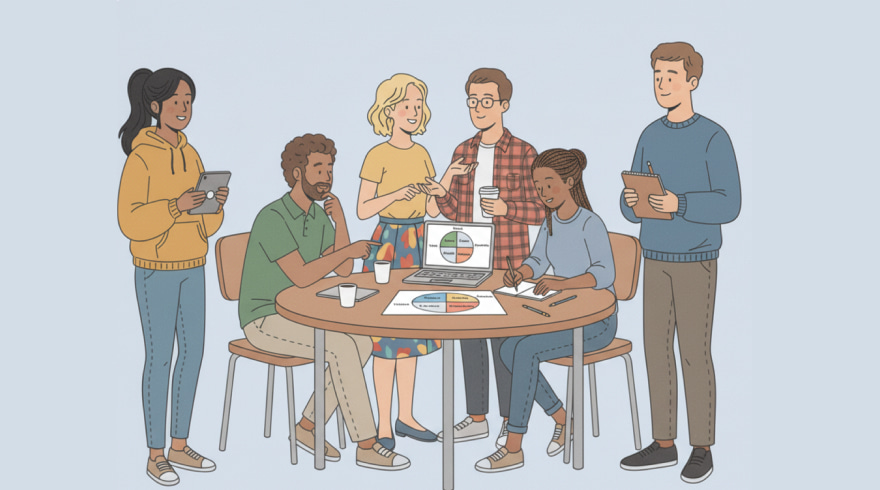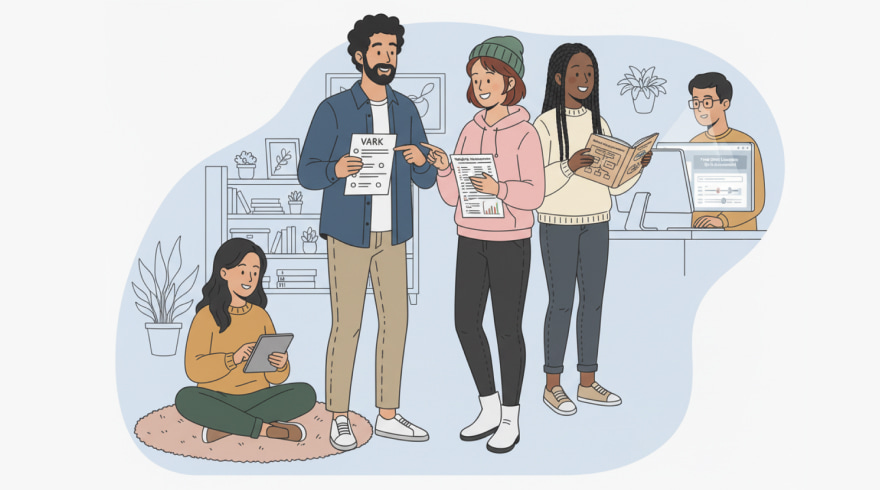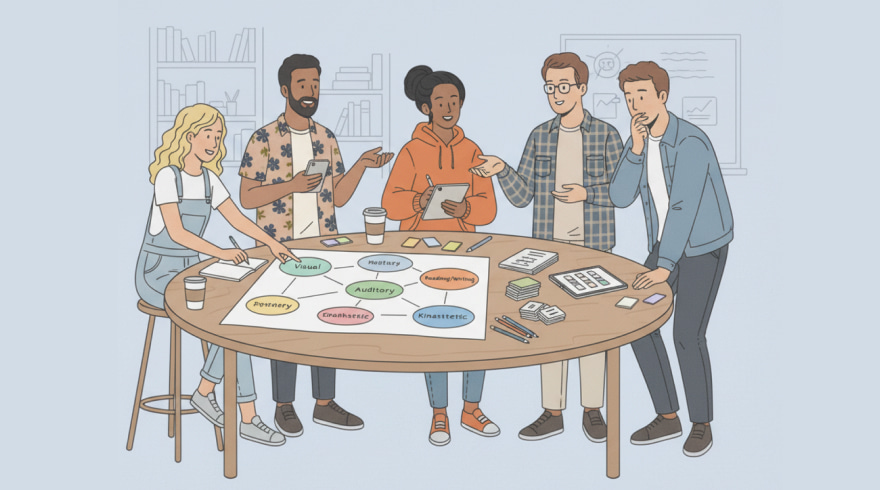The Guide to Personalized Learning Preferences and Reflective Evaluation
- 29 October 2025

Why Personalizing How You Learn Changes Results
Most people study harder when they feel progress is within reach, yet effort alone doesn’t guarantee improvement. The real unlock is making your study tactics fit the way your brain processes information, your environment, and your goals. That means noticing what clicks, removing friction, and iterating based on evidence rather than guesswork. When you align tasks, time, and tools with your cognitive habits, attention lasts longer, and recall strengthens. Instead of forcing universal methods, you adapt and fine-tune. Over weeks, these small optimizations compound into a deeper understanding and faster outcomes.
In practice, learning style and self-assessment operate as a feedback loop that translates raw effort into targeted progress. Rather than locking yourself into rigid labels, think of preferences as starting points for experimentation and course correction. Create brief checkpoints after study sessions, observe what felt easy or draining, and adjust formats, pacing, and support materials. By treating improvement as an iterative design problem, you step away from one-size-fits-all advice and build a repeatable system that’s precise, humane, and resilient.
- Turn implicit habits into explicit strategies you can measure and refine.
- Reduce cognitive load by matching tasks to context, time of day, and energy levels.
- Choose study media, text, audio, visual, or hands-on, based on evidence, not trends.
- Eliminate unhelpful techniques and double down on high-yield patterns.
- Build confidence through visible wins and consistent, data-informed practice.
Decoding Learning Preferences, Modalities, and Context
Understanding how you learn starts with mapping your strongest channels for intake and output. Some people grasp ideas quickest through diagrams, others through discussion, and many through practice and feedback. Models such as VARK, Kolb’s experiential cycle, and Gardner’s frameworks provide language to discuss differences, but they are most useful when paired with observation and results. The goal is not to box yourself in; it is to expand your repertoire and know when to deploy each method. Context matters just as much: time constraints, task difficulty, prior knowledge, and motivation can shift the “best” approach from day to day.
Across classrooms and workplaces, learning styles and self-assessment align expectations, reduce friction, and amplify retention. You might draft notes in visuals for concept-building, switch to spaced recall for memorization, and then teach the idea to someone else to cement transfer. Over time, this tactical switching builds agility. When you can diagnose what a task demands, precision, creativity, speed, or endurance, you can match the right modality to the right moment, turning study from a chore into a strategic practice.
- Visual: sketches, flowcharts, annotated timelines
- Auditory: discussion, podcasts, explain-aloud sessions
- Reading/Writing: structured notes, summaries, retrieval prompts
- Kinesthetic: demos, labs, real-world simulations, role-play
- Social and solitary blends depending on complexity and stakes
The Role of Reflection and Measurement in Growth
Progress accelerates when reflection becomes routine. Short debriefs after study sessions reveal what worked and what didn’t while the experience is fresh. Metrics don’t need to be elaborate: time on task, recall accuracy, error categories, and perceived effort are a solid start. Tie these snapshots to your goals and revisit them weekly. Patterns appear quickly, perhaps diagrams help with frameworks but not with dates, or morning sessions beat evening ones. This lightweight analytics habit converts hunches into decisions and keeps motivation grounded in evidence.
For individuals seeking clarity, learning style self-assessment becomes a structured mirror that reflects strengths and blind spots. The point isn’t to chase a single “type,” but to discover a personal toolkit and the conditions under which each tool shines. Combine quick questionnaires with performance tasks, like solving problems out loud or teaching a mini-lesson. Then compare perceived preferences with actual outcomes to close the gap between what feels comfortable and what reliably delivers results.
- Log inputs (methods used) and outputs (scores, recall latency, error types).
- Review weekly to identify “high-yield” technique–topic pairs.
- Test small changes, timing, breaks, format, and keep what sticks.
- Use reflection prompts: What was clear, confusing, or surprisingly easy?
- Translate insights into next-week experiments to avoid stagnation.
How to Plan and Run an Assessment That Actually Helps
Good diagnostics are brief, relevant, and actionable. Start with your target outcome, such as mastering terminology or solving multi-step problems, and design checks that mimic the real demand. Mix self-report items with performance samples to balance perception and proof. Keep friction low: five to ten minutes is enough for frequent check-ins. Afterward, summarize insights in plain language and set one or two concrete adjustments. The best assessments are the ones you’ll actually use regularly.
When you need a snapshot, learning style self assessment test formats offer quick diagnostics without sacrificing nuance. Blend closed-ended items with short reflections so you capture both patterns and exceptions. Then schedule a follow-up trial using the recommended methods in a live task. If results improve, codify the change; if not, pivot quickly. With this cycle, your learning system adapts to you, not the other way around.
- Define success criteria linked to your current course or project.
- Create a short inventory plus a brief, authentic task sample.
- Record what you did, how it felt, and what the outcome was.
- Decide one experiment to run next time and set a reminder.
- Repeat, compare, and retire tactics that no longer earn their keep.
Making Sense of Your Results and Turning Insight Into Action
Interpreting results is where growth actually happens. Look for signal, not noise: a single session can mislead, but trends across several attempts tell the story. Beware of comfort masquerading as effectiveness, an easy-feeling method isn’t always the most powerful for retention or transfer. Pair qualitative notes with quantitative markers like quiz scores, time to recall, or reduction in errors. Then create a simple playbook that assigns study methods to task types, so choosing a tactic becomes automatic.
As patterns surface, learning styles self assessment results should be translated into actionable experiments rather than fixed labels. You might decide that visual mapping works best for theories, whereas timed retrieval fuels vocabulary. Rotate methods deliberately to prevent plateaus, and build “metacognitive checkpoints” into your calendar to ensure you update your strategy as courses, projects, or roles evolve. Over months, you’ll assemble a customized workflow that travels well across subjects and challenges.
- Map methods to tasks: comprehension, memorization, application, synthesis.
- Use spaced intervals and interleaving to strengthen durable learning.
- Upgrade notes into retrieval prompts rather than passive rereads.
- Teach or coach others to stress-test your understanding.
- Track wins in a simple dashboard to keep momentum visible.
Tools, Frameworks, and Resource Map
With countless tools available, the key is curating a small, dependable stack. Choose one place to capture insights, one method to test them, and one routine to review. Digital flashcards, whiteboards, voice memos, and lightweight analytics can cover most needs. Pair these with a clear workflow: plan, practice, check, and adjust. If you’re working in a team or class, agree on shared checkpoints and vocabulary so collaboration supports, not distracts from, your goals.
If budget is tight, free learning style self assessment tools can still produce reliable direction when chosen thoughtfully. Look for transparency about what a quiz measures, examples of recommended tactics, and guidance for interpreting edge cases. Blend survey-driven insight with a quick, authentic task to validate results against reality. Keep your toolkit lean, and focus on consistency over novelty to protect your attention and time.
| Tool or Method | Best Use | Time Needed | What You Learn |
|---|---|---|---|
| Modality questionnaire | Initial preference mapping | 5–8 minutes | Likely input channels and comfort zones |
| Retrieval practice set | Memory and transfer checks | 10–15 minutes | Recall strength and error patterns |
| Concept map sketch | Structuring complex topics | 8–12 minutes | How ideas connect and where gaps remain |
| Teach-back recording | Depth of understanding | 6–10 minutes | Clarity, misconceptions, and fluency |
| Study log with metrics | Weekly optimization | 3 minutes daily | Which tactics produce the best returns |
FAQ: Quick Answers
Are learning preferences fixed or flexible over time?
Preferences are starting points, not permanent labels. They evolve with experience, subject matter, and context, so revisit your approach each term or project and update the tactics that no longer perform.
How do Gardner’s ideas relate to practical study choices?
The theory highlights that people can excel across diverse cognitive domains such as spatial, linguistic, or interpersonal strengths. In many cases, multiple intelligences self assessment questionnaires complement modality checklists by mapping broader cognitive tendencies so you can pick study activities that play to your profile while still stretching weaker areas.
What’s the simplest way to start measuring progress?
Track three items for two weeks: time on task, recall accuracy after a delay, and one reflection sentence on what felt effective. Use the data to choose one improvement experiment per week and iterate.
How often should I change my study methods?
Rotate methods when the task changes or when your results plateau for two or three cycles. Keep a core routine for stability, but introduce small adjustments to sustain growth and avoid diminishing returns.
Can teams or classes use the same framework?
Yes, shared check-ins and common language make coordination easier. Encourage each person to personalize tactics within the framework so the group benefits from structure without losing individual fit.
Latest News
-
![A Complete Guide to the VARK Model and Personalized Learning Preferences]() A Complete Guide to the VARK Model and Personalized Learning Preferences Take Learning Style Assessment Online Get Started What VARK Is and Why Learning Preferences Matter The VARK framework classifies how individuals tend to absorb, process, and recall information across four modalities: Visual, Aural, Read/Write, and Kinesthetic. Instead of c...
A Complete Guide to the VARK Model and Personalized Learning Preferences Take Learning Style Assessment Online Get Started What VARK Is and Why Learning Preferences Matter The VARK framework classifies how individuals tend to absorb, process, and recall information across four modalities: Visual, Aural, Read/Write, and Kinesthetic. Instead of c... - 3 November, 2025
-
![Understanding and Using Multiple Intelligences: A Complete Assessment Guide]() Understanding and Using Multiple Intelligences: A Complete Assessment Guide Take Learning Style Assessment Online Get Started Foundations of Multiple Intelligences Test Human capability is a mosaic, not a single metric, and this insight sits at the heart of the multiple intelligences perspective. Instead of ranking people on a narrow academic scal...
Understanding and Using Multiple Intelligences: A Complete Assessment Guide Take Learning Style Assessment Online Get Started Foundations of Multiple Intelligences Test Human capability is a mosaic, not a single metric, and this insight sits at the heart of the multiple intelligences perspective. Instead of ranking people on a narrow academic scal... - 31 October, 2025
-
![The Complete Guide to Understanding and Using Learning Style Assessments]() The Complete Guide to Understanding and Using Learning Style Assessments Take Learning Style Assessment Online Get Started Why Understanding Your Learning Style Matters Most people study harder when they could study smarter, and that difference often stems from knowing how the brain prefers to take in, transform, and remember information. A tho...
The Complete Guide to Understanding and Using Learning Style Assessments Take Learning Style Assessment Online Get Started Why Understanding Your Learning Style Matters Most people study harder when they could study smarter, and that difference often stems from knowing how the brain prefers to take in, transform, and remember information. A tho... - 30 October, 2025



